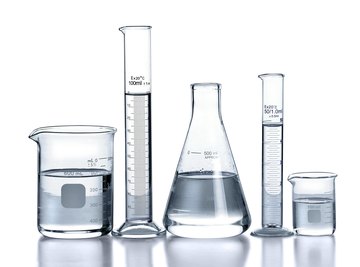
Scientists evaluate experimental results for both precision and accuracy, and in most fields, it's common to express accuracy as a percentage. You do this on a per measurement basis by subtracting the observed value from the accepted one (or vice versa), dividing that number by the accepted value and multiplying the quotient by 100. Precision, on the other hand, is a determination of how close the results are to one another. If the results of an experiment are precise but inaccurate, that usually indicates a problem with the experimental methodology or equipment.
Formula for Percent Accuracy
In an experiment observing a parameter with an accepted value of VA and an observed value VO, there are two basic formulas for percent accuracy:
(VA - VO)/VA X 100 = percent accuracy
(VO - VA)/VA x 100 = percent accuracy
If the observed value is smaller than the accepted one, the second expression produces a negative number. It's easy to avoid this, but in some cases, negative values for percent accuracy can yield useful information.
Keeping Things Positive
In an experiment or test with multiple trials, researchers may want to average the percent accuracy – or percent error – of all the results to evaluate the experiment as a whole. Negative values for percent accuracy would skew the average toward zero and make the experiment appear more accurate than it is. They avoid this by using the absolute value of the difference between the observed and accepted values:
Percent accuracy = (VA - VO)/VA X 100 = (VO - VA)/VA X 100
For example, you may be testing a new type of thermometer that measures outside temperature by the electric current generated by a heat-sensitive material. You take a reading with the device and get 81 degrees Fahrenheit, while an accurate conventional thermometer reads 78 degrees Fahrenheit. If you're only interested in the accuracy of the new thermometer and don't care whether the temperature is lower or higher than the accepted value, you would use an absolute value in the numerator to calculate the percent accuracy:
(78-81)/78 X 100 = (81-78)/78 X 100 = 3/78 X 100 = 0.0385 X 100 = 3.85 percent
Negativity Can Be Useful
Positive and negative fluctuations of the observed value from the accepted one can yield important information. When researchers need this information, they don't take the absolute value of the difference between accepted and observed values, which allows the percentage to be negative.
In the thermometer experiment described above, allowing the error calculations to be negative would produce a percent accuracy of -3.85 percent. A series of measurements and error calculations would tell you whether the thermometer tended to record the temperature as too high or too low, and that could give you valuable information about the properties of the material you're using.
References
About the Author
Chris Deziel holds a Bachelor's degree in physics and a Master's degree in Humanities, He has taught science, math and English at the university level, both in his native Canada and in Japan. He began writing online in 2010, offering information in scientific, cultural and practical topics. His writing covers science, math and home improvement and design, as well as religion and the oriental healing arts.
